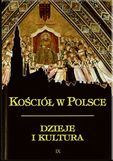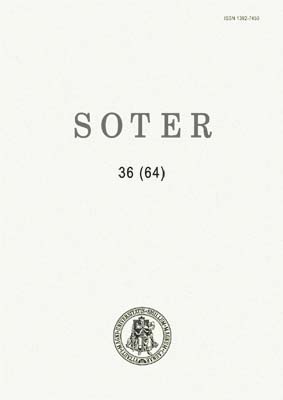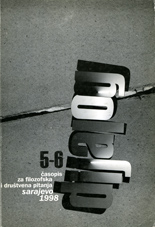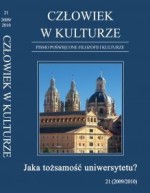We kindly inform you that, as long as the subject affiliation of our 300.000+ articles is in progress, you might get unsufficient or no results on your third level or second level search. In this case, please broaden your search criteria.
Not any of the Church leaders have ever known like Fotius, both from his contemporaries and posterity, a so divided judgment. Whereas in the Roman-Catholic Church he is detested as a conceited and irresponsible intruder (being regarded as the ancestor of the schism named after him), he is however celebrated as a saint (just as the apostles) and ecumenical father within the Orthodox Church. The present research is dedicated to the presentation of the main aspects of Fotie of Constantinople`s life and work. A vast bibliography is used, from the classical works of Hergenröther and Dvornik to the best articles from the theological and intellectuality dictionaries concerned with the subject. The research achieves a critical presentation of the biography and of the most important ideas of his theological thinking. He was born in Constantinople, sometime between 810-820, in a noble family of Macedonian dynastic origin that suffered a lot during iconoclastic times of the emperors Leon V (813-820) and Teofil (829- 842). He was the son of the Sergiu, a civil servant from the imperial court and a close relative of both Irina and the ecumenical patriarch Tarasie. When he was about 20 years old Fotiea already became a professor at the Constantinople University. His vast erudition ensured him the possibility of teaching logics, dialectics, and theology, afterwards becoming first secretary, sword bearer and herald of the emperor in Orient.
More...
Ieromonah Petru Pruteanu, Liturghia Ortodoxă. Istorie şi actualitate, Bucureşti, Edit. Sophia 2008, Recenzie de Dumitru Vanca; Arhiepiscop Dr. Andrei Andreicuţ, Dialog al vremii cu memoria. Slujind Domnului şi poporului său la începutul mileniului III, Alba Iulia, Editura Reîntregirea, 2009, Recenzie de Iosif Zoica
More...
Ignoring the subconscious in the study of Theology. Eugen Drewermann and the objective of self-knowledge. We named our study “Ignoring the subconscious in the study of Theology” because any graduate of a Theological Faculty is aware of the fact that along his theological studies, the term “subconscious” was never an issue even in studies such as Christian Ethics, Spiritual Development and Pastoral, where its use would have been justified. That's because it brings into question a reality not so much discussed in Theology, despite its importance. This is partially explained by the camouflaged denial of Freud (who was the initiator of focusing the attention on the subconscious) by theologians, generally because he was accused of an unacceptable pan-sexualism. More precisely, the situation is the result of an insufficient interdisciplinary dialog between theology and psychology.
More...
Saint Basil the Great: interaction between “church porch of culture” and “nave of theology”– hermeneutic exercise on homily Speech for the youth. This apologetic interaction between pagan philosophers and Holy Fathers of Church was possible thanks to the latter because they didn’t leave aside the ideological arsenal brought for debates by the former. On the contrary, Holy Fathers proved out that they were acquainted with the social, cultural and theological problems of those times. They were conscious of the fact that heathenism, profane culture needs to be submitted to an intense process of conversion and contrast.
More...
Martyrdom in the Church is a constant reality, not a characteristic trait of a time of persecution. Thus, in the Middle Ages, although on a smaller scale than previously, there were cases of witness to Christ given by shedding one’s blood. However, in this period we find another dimension of martyrdom. It was linked to monastic life. Martyrdom of the time crowned the life of the apostle to the pagans, which was flight (withdrawal) from the world. We have examples of this such as Saint Adalbert, the Five Martyred Brothers, or Saint Bruno-Boniface. Another form of martyrdom in the Middle Ages is the defense of the faith and the rights of the Church. It consisted of bearing witness to the faith, Christian morality, or the rights of the Church to sovereigns, including those who were Catholic. We have models of this in Saint Stanislas, the bishop of Płock Werner, and a Krakow vicar, Martin Baryczka. Another form of martyrdom is the death for the faith suffered at the hands of pagans or heretical invaders. This period runs in Poland from the middle of the thirteenth century to its end. There were several Christians in Poland who gave their lives in this way, but written evidence is lacking, which is why the Church’s recognition has only been given to certain acts of martyrdom. We have an example of this in the person of the holy Dominican of Sandomierz who was called Sadok and his companions. The martyr, by his attitude, reminded and admonished people, exhorted and warned them. He reminded them of the need for asceticism in Christian life, in other words, for a continuous effort over oneself; he also reminded of the urgent duty to announce the Gospel. Then he exhorted to make a profession and courageous defense of the faith by one’s entire life, without reservations. He warned of the moral disorder that is a catastrophe for man and for society. For the people of the Middle Ages, martyrdom meant a struggle, in which man becomes not only athleta Christi, “fighter or athlete of Christ,” but even a true miles, “knight.”
More...
Gimus bioetikai, jos pionieriai ir kiti šioje srityje dirbantys ekspertai išreiškė viltį, kad medicinos mokslo ir praktikos paradigma, gimusi XIX a. viduryje, turės užleisti vietą naujai paradigmai – mechanistinį požiūrį į žmogų pakeis integralus požiūris į žmogų, kaip į fizinę ir dvasinę vienovę. Straipsnyje bandoma atskleisti religijos ir teisės, religijos ir medicinos sąveikos svarbą bioetikos sprendimams, kurie turėtų prisidėti prie naujosios paradigmos įsigalėjimo. After the birth of bioethics its pioneers and other experts operating in that field express their belief about the event of a new paradigm in medical science and practice. The old paradigm with its Cartesian mechanical approach to human nature should be substituted by the holistic approach in medicine which could help to treat a person as physical and spiritual unity. Bearing this in mind the present article analyses what the role in bioetical decisionmaking could be attached to the interaction between religion and law, and between religion and medicine.
More...


Pastoracijos teologija teigia, kad Marijos kultas negali būti atsietas nuo kristologinio ir ekleziologinio konteksto. Pamaldumas Švč. Mergelei Marijai Katalikų Bažnyčios gyvenime yra tapęs nuolatine sielovados žyme, katalikiškų šeimų maldos palydovu, remiantis juo organizuojamos įvairios katalikiškos brolijos, puoselėjamos kitos maldingumo praktikos. Tačiau pamaldumo praktikos dėl formų įvairovės neretai prasilenkia su tikėjimo turiniu, todėl sielovada turi nuolat ieškoti būdų, kaip konkrečioje sociokultūrinėje aplinkoje padėti marijiniam pamaldumui išlaikyti autentišką prasmę. Katalikiškos autentikos ir ekumeninių siekių perspektyvoje ypač skatintinas pasivedimas Marijos globai tikėjimo piligrimystėje, siekiant tobulesnio ryšio su Eucharistiniu Jėzumi. Pastoral theology states that the Marian devotion cannot be separated from the Christological and ecclesiological perspectives as it has become very significant in the ministry of the Catholic Church. Furthermore, the Marian devotion is very important for the spiritual life of families and various Catholic communities. But some practices of the devotion in certain sociocultural environment do not reveal the true faith the Church has, thus the ministry must always guarantee the Marian devotion to keep the authentic meaning.
More...
Apreiškimo scena yra viena svarbiausių tiek Švč. Mergelės Marijos kulto reiškinyje, tiek krikščioniškajame mene. Dievo pasiuntinio arkangelo Gabrieliaus, apreiškusio Viešpaties valią Mergelei Marijai, vaizdinys šioje naratyvinėje scenoje neatsiejamas nuo Marijos. Šiame straipsnyje nagrinėjami Viešpaties Apreiškimo Švč. Mergelei Marijai atvaizdai (XVI–XVIII a. Lietuvos bažnytinės dailės objektai). Naudojant ikonografinį-ikonologinį ir ikonoteologinį metodus gilinamasi į šių atvaizdų specifiką, į žemiškosios Mergelės Marijos ir Viešpaties angelo santykį, analizuojama, kaip kinta jų įvaizdis keičiantis Apreiškimo scenos ikonografinei schemai, nagrinėjami teologinės bei pamaldumo tradicijos atspindžiai šiuose atvaizduose. Straipsnis parengtas pranešimo, skaityto konferencijoje „Virgo venerabilis: Marijos paveikslas Lietuvos kultūroje“ (vykusioje 2009 m. Vilniuje, Kultūros, filosofijos ir meno institute), pagrindu. The Annunciation is one of the most important scenes both in Christian art and in the cult of the Blessed Virgin Mary. The image of Archangel Gabriel as a messenger of God, who manifested the will of the Lord to the Virgin Mary is inseparable from Mary in this narrative scene. The images of Annunciation (the church art objects of Lithuania of the 16th–18th centuries) are analysed in this article. The iconographic-iconologic and icontheological methods will be used with the purpose to explore the particularities of these images, the relation between the human Virgin Mary and the Angel of the Lord, how their image is changing according to variation of the iconographic scheme, as well the reflections on the theological and devotional traditions in these images. The article is based on the discourse of the conference “Venerable Virgo: the Image of the Blessed Virgin Mary in Lithuanian Culture” (held in Vilnius, at the Institute of Culture, Philosophy and Art in 2009).
More...
Straipsnyje apibūdinama Helio pusiasalio kašubų liaudies pamaldumo kaita. Dvidešimtojo amžiaus antrojoje pusėje žvejų gyvenvietės tapo poilsiavietėmis. To pasekmė – laipsniškas ir besitęsiantis liaudies pamaldumo (kuris tradiciškai praktikuotas šeimoje ir kaimyninėse bendruomenėse) menkėjimas ir nykimas. Pirmajame skyriuje apibendrinami kultūrinės antropologijos tyrinėjimai Kašubijos regione. Antrajame skyriuje atskleidžiamas ekonominis, geografinis ir kultūrinis Helio subregiono savitumas. Trečiajame skyriuje analizuojami pasirinkti liaudies pamaldumo pavyzdžiai ir kaitos, vykusios šiame regione pastarąjį dvidešimtmetį, procesas. This article describes the process of transformation of the popular (folk) religiosity of the Kashubian inhabitants of the Hel Peninsula. In the second half of the twentieth century the fishing settlements were transformed into holiday resorts. As a consequence, one can observe gradual and continuing reduction and impoverishment of folk religiosity traditionally practised in families and neighbouring communities. The first chapter summarizes the achievements of cultural anthropology studies in Kashubian region. The second chapter shows the economic, geografic and cultural specific of the Hel Peninsula sub-region. The third part analyzes selected phenomena of folk religiosity and the process of transformation which in this area took place in the last twenty years.
More...
Šiuo straipsniu siekiama parodyti meditacijos ir kontempliacijos skirtumus, aptarti kontempliatyviąją meditaciją, atskleisti kontempliaciją kaip tikrąjį žmogaus buvimą, kaip išbudimą giliausiai tikrovės atverčiai. Meditacijai tampant kontempliacija, įvyksta paradoksalus ontologinis virsmas: transcendencija, Begalybė, įsikuria žmogaus viduje, imanencijoje. Šis virsmas atveria dieviškosios Tikrovės slėpinius ir mūsų esaties gelmes, sukuria tikrąją tapatybę, naująjį „aš“, vedamą Dievo valios „balso“. Dievas priima žmogų į savo tikrovę, savo slėpinį ir savo laisvę. The aim of this article is to show differences between meditation and contemplation, to discuss a contemplative meditation, to reveal contemplation as a true being of a man and as an awakening for the deepest opening of reality. When meditation becomes contemplation, a paradoxical ontological transformation occurs: transcendence, the Infinite, settles inside a human being, in the immanence. This transformation opens the mysteries of Divine Reality and the depths of our presence, creates the true identity, the new “I” which is guided by the “voice” of God’s will. God welcomes a man in His reality, His mystery and His freedom.
More...

Dievo kaip Tėvo įvaizdis krikščioniškoje teologinėje literatūroje dažniausiai yra aptariamas pasiremiant Naujuoju Testamentu. Kadangi nuorodos į Senąjį Testamentą dažnai esti bendresnio pobūdžio, nenuostabu, kad kiti žydų raštai, kurie nepriklauso nei žydų, nei krikščionių Šventojo Rašto kanonui, nors parašyti panašiu laikotarpiu, susilaukia dar mažiau dėmesio. Šiame straipsnyje pristatomos ir susintetinamos kai kurių autorių analizės ir įžvalgos apie tarptestamentinę literatūrą, kurioje tiesiogiai ar netiesiogiai kalbama apie Dievo tėvystę. Visi tekstai suskirstyti į tris grupes: tekstai, kuriuose minint Dievą vartojamas terminas „tėvas“; tekstai, kuriuose Dievo tėvystė žmonių atžvilgiu gali būti suprantama, kai jie vadinami jo „vaikais“; ir tekstai, kuriuose Dievas traktuojamas „kaip tėvas“. The image of God as Father in Christian theological literature is usually analyzed with reference to the New Testament. Since references to the Old Testament are often treated in a more general (basic) way, there is no surprise that those Jewish writings which do not belong either to a Jewish or Christian Canon of the Holy Scripture are usually overlooked, though they may possibly belong to the same milieu as regards their religious ideas or time of composition. This article, namely, presents and summarizes analyses and insights on the topic of several outstanding scholars. The analyzed texts are grouped under three headings: texts in which the term “father” is employed with regard to God; texts, where people are called God’s “sons”; and texts, in which God is spoken of “as father”.
More...
Naujajame Testamente užfiksuota pirmųjų krikščionių bendruomenių atgailos praktika atspindi ankstyviausius bandymus įgyvendinti Jėzaus mokymą apie nuodėmę, atsivertimą ir atleidimą. Drauge tai yra ištakos, turėjusios įtakos vėlesnei Atgailos sakramento sampratai. Čia aptinkami mokymo bei praktinio įgyvendinimo aspektai gali praversti kaip Atgailos sakramento dabartinės praktikos vertinimo kriterijus ir paskatinti ją atsinaujinti. The practice of penitence of the first Christian communities as fixed in the New Testament reflects the earliest attempts to implement Jesus’ teachings about sin, conversion and forgiveness. At the same time, these are the sources that inspired later concept of the sacrament of penitence. These aspects of the doctrinal and practical implementation of penitence we see here can serve us as criteria for the evaluation of today’s sacramental practice of penitence and provide us with precious impulses for its vivification.
More...
Povodom pedesete godišnjice Deklaracije Ujedinjenih naroda o ljudskim pravima, promuIgirane 10. prosinca 1948. godine, postavljaju se različita pitanja i religijama i vjerskim zajednicama, o njihovom odnosu prema ljudskim pravima općenito i njihovoj ulozi u borbi protiv praktičnih kršenja ljudskih prava. Drago mi je da upravo Akademija nauka i umjetnosti Bosne i Hercegovine, institucija od najvišeg znastvenog ugleda formalno-pravno i stvarno i sama postavlja pitanje religije i ljudskih prava. Naime, više puta sam upozoravao da su komunisti religiju desetljećima marginalizirali, a nacionalisti instrumentalizirali i čak zloupotrebI javali u ideološke i dnevnopolitičke svrhe, pa nije jednostavno reći nešto sasvim istinito o naslovljenoj temi.
More...
O pitanju odbrane ljudskih prava u njihovom današnjem obliku govori se od II svjetskog rata, mada su zapravo napadanje i ugrožavanje tih prava stari koliko i sam početak društvenog života odnosno osjećaj za zla koja donose ti napadi i nužnost odbrane. Svi Božiji poslanici kao jedan od ciljeva svoje misije, tj. poslanstva, navode slobodu i zaštitu čovjeka od zuluma - napada nasilnika, te uspostavu društva u kome će biti ispoštovana prava svih ljudi. Kroz historiju pored svakog nasilnika, koji je ugrožavao ta prava, postojao je i po jedan poslanik, kome je, pak, bila povjerena borba protiv tog zla.
More...
The article presents a peculiar mission of the University of Navarra – an ambitious program carried out for over 50 years, outlined by its founder – St. Josemaría Escrivá, a program which reflects a logic of the thinking and the work, whose primary objective is to sanctify by working in the world. It deserves a special attention on account of its “interdisciplinarity” (in the sciences and the humanities) as its own feature of projects implemented by the UN, its internationalization, and such modeling of the culture, which reflects the authentic values.
More...
The Author analyzes the impact of Cardinal Newman on a shape of “Ex Corde Ecclesiae” by Pope John Paul II. As pointed out, it seems very likely, as it can be seen by looking at the footnotes, where there are three direct references. A detailed analysis of the document shows, however, that the echo of Newman's voice resounds in it loudly and clearly; that it is undoubtedly filled in its essence with a thought and spirit of John Henry Newman. In his deliberations the Author plays a role of a guide, who - while tracing a path from the Cardinal to the Pope - follows a seemingly daring question: was Newman a “hidden author” of Ex Corde Ecclesiae?
More...